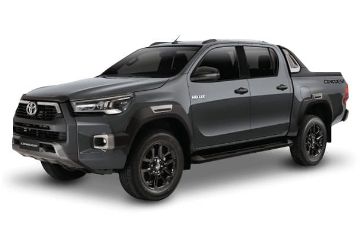![The Toyota Hilux -- a rollover risk no more 01]()
Reliability, durability, and longevity have long defined the Toyota Hilux pick-up truck.
Whether you own a farm and need a super-tough hauler or a city slicker who wants to take on inhospitable urban streets without fear, the Hilux can handle whatever you throw at it.
But Toyota’s tough truck had one potentially deadly flaw until five years ago – it could tip over when avoiding obstacles at speed.
Avoiding the moose
The test that had long flummoxed Toyota’s best-selling pick-up is the “moose test” conducted by Swedish car magazine Teknikens Varld.
Sweden has short days and long nights most of the year, with many roads cutting through dense forests where wild animals like moose (which can weigh up to 700 kilograms) cross the road.
In 2019, there were seven fatal car crashes in Sweden, six involving collisions with moose.
Thus, the magazine tests how fast a car can maneuver around such an obstacle using a simulated course made with pylons. The test driver goes faster until the car hits the pylons or starts to tip over.
The test is performed at the vehicle’s maximum weight, which often involves loading it up with passengers.
Now the Philippines doesn’t have any moose. Still, the test can replicate avoiding cows on a dark provincial road, a pedestrian suddenly jumping into a street, or a tricycle deciding to make a U-turn in front of you.
Too much grip
The first high-profile moose test failure was the first-generation Mercedes-Benz A-Class hatchback evaluated by Teknikens Varld in 1997.
Photos of the top-heavy, emerald-green hatchback dramatically riding on its right wheels, on the verge of tipping over, made such a shock that Mercedes-Benz fitted an aggressive electronic stability control system and revised the suspension on the A-Class afterward.
Ten years later, the Hilux would face the same struggles.
Teknikens Varld noted that when it tested the previous-generation Hilux in 2007, the left-side suspension bottomed out, and the right-front wheel lifted at just 57 km/h, with the test driver making corrective action to stop the pick-up from landing on its roof.
The publication blamed the generous grip levels provided by the optional 16-inch wheels on the Hilux test unit.
“The grip was too good and in combination with a high center of gravity and the absence of electronic stability control, the Toyota Hilux was close to roll over,” the magazine said.
“After the incident, Toyota throughout Europe halted the sales of Hilux with the bigger wheels,” Teknikens Varld added.
Here we go again
The current-generation Hilux, launched in the Philippines in July 2015, likewise performed poorly in the moose test.
On September 2016, the Swedish magazine tested a Hilux against its main rivals. All the vehicles were equipped with electronic stability control, which can control the engine power and brakes to prevent rollovers.
The publication noted that the other pick-ups were able to clear the course at 64 to 68 km/h, with many just understeering into the pylons at the limit.
However, the Hilux was hurtled into the course at 60 km/h, with the test driver getting up on two wheels from what seemed like too much grip.
“I am totally focused on getting the car into the first lane again, and I notice nothing until we are about to tip over,” said Teknikens Varld test driver Oskar Krüger. “Then I countersteer, and the wheels get back on the ground.”
The Hilux tested by the magazine came with 265/60R18 wheels and tires. The magazine said the Hilux with 17-inch wheels performed marginally better but still lifted its inside wheel.
“I think the problem lies in the absence of anti-rollover systems and the grip of the tires, said Teknikens Varld Ruben Börjesson.
Hilux passes its retest
Following this shocking result, Toyota implemented two measures to prevent rollovers with the Hilux.
For one, the Japanese carmaker increased the recommended tire pressures for the pick-up at higher loads.
Second, it revised the electronic stability control system so that it cuts in more aggressively in high-speed avoidance maneuvers.
In a March 2017 test of the Hilux, the pick-up was able to clear the course at up to 67 km/h with no drama.
Making cars safer
While many have criticized the relevance and methodology of the Teknikens Varld moose test, it did succeed in making numerous vehicles safer, including the Hilux.
The test exposed potentially lethal handling characteristics designed into the vehicle, to the point that even technologies like electronic stability control could not overcome these.
And the corrective action made by Toyota ensured that its ultra-tough pick-up would not go wheels-up when faced with obstacles on the tarmac.
Toyota Motor Philippines also announced on October 2022 that the Hilux had beefed-up active safety systems.
While all Hilux variants come with electronic stability control, the top-of-the-line Hilux Conquest and Hilux GR-S variants also have a Pre-Collision System, Adaptive Cruise Control, and Lane Departure Alert.
The GR-S adds a Blind Spot Monitor and Rear Cross Traffic Alert.
Some of these systems can reduce the likelihood or severity of a road crash and can be switched off for off-road driving.
Do you think more cars should go through a moose test?






